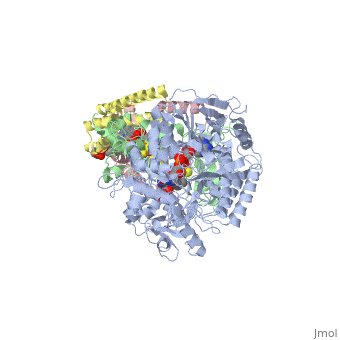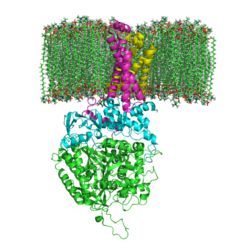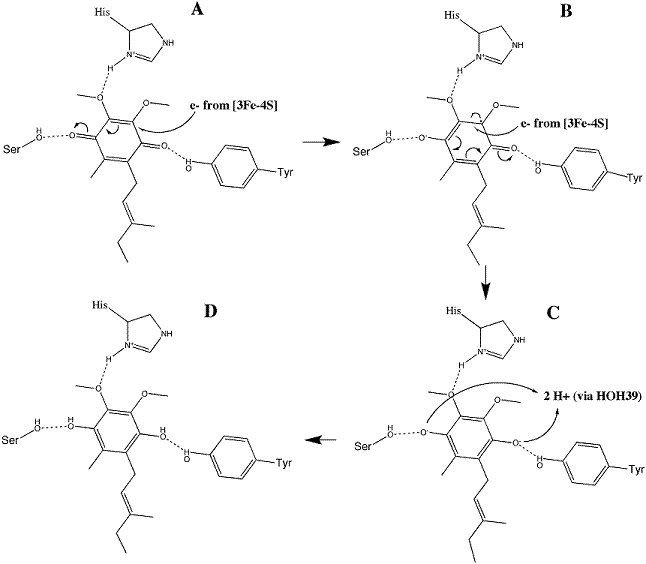Function
Succinate Dehydrogenase (PDB = 2wdv with empty ubiquinone binding site; PDB = 1nek with ubiquinone bound), also called succinate-coenzyme Q reductase (SQR) or Complex II, is a tetrameric enzyme found in the cell membrane of http://proteopedia.org/wiki/index.php?title=Succinate_Dehydrogenase&action=editsome bacteria and the inner mitochondrial membrane of mammalian cells. It is classified as an α+β protein, as it contains of α helices and antiparallel β sheets. It is involved in two aspects of digestion; it catalyzes the oxidation of succinate to fumarate in the citric acid cycle by simultaneously reducing ubiquinone to ubiquinol in the electron transport chain [1]. See also:
Structure
The tetramer is composed of . The hydrophilic subunits are named SdhA (PDB = 2wdq) and SdhB; the former is a flavoprotein containing a covalently-bound FAD cofactor and a binding site for succinate, while the latter is a Fe-S protein bearing the three iron-sulfur clusters 2Fe-2S, 3Fe-4S, and 4Fe-4S. The hydrophobic subunits, termed SdhC and SdhD, anchor the protein in the mitochondrial membrane and formally comprise cytochrome b [2] [3]. This cytochrome contains six transmembrane α-helices, a heme b group, and a binding site for ubiquinone located in a space bounded by SdhB, SdhC, and SdhD [3] [4].
Binding sites
Succinate
The binding site for succinate, in which the stereospecific dehydrogenation of succinate to fumarate is catalyzed, is located entirely on SdhA. stabilize the substrate with hydrogen bonding, while FAD removes the electrons and carries them to the first iron-sulfur cluster, 2Fe-2S, of SdhB [5]. During this transfer, FAD is reduced to FADH2 [6]. The Km for this reaction is approximately 10E(-3), while the Vmax is approximately 100 nmol/min/mg of protein [7].
Ubiquinone
The binding site for ubiquinone, in which the substrate is reduced to ubiquinol, is bordered by subunits B, C, and D. Residues His207 of SdhB, Ser27 and Arg31 of SdhC, and Tyr83 of SdhD stabilize ubiquinone, while residues Pro160, Trp163, Trp164, and Ile209 of SdhB and Ser27 and Ile28 of SdhC provide the necessary hydrophobic environment that stabilizes the ring [4]. In the associated figure from PDB 1nek, the
as follows: orange indicates the FAD cofactor, green shows the Fe-S clusters, cyan indicates ubiquinone in its binding site, yellow shows Ca2+ ions, navy blue indicates oxaloacetate, pink is cardiolipin, brown is ephrin, and the heme group is indicated by the lime green structure. The exact function of some of these ligands with regard to succinate dehydrogenase remains unclear; ephrin, for example is suspected to be involved in certain cell signaling pathways in animal development [8].
Mechanisms
Succinate oxidation
The exact mechanism for the oxidation of succinate to fumarate has not yet been elucidated. The initial deprotonation may be performed by FAD, Glu255, Arg286, or His242 of SdhA, and the following elimination may be a concerted E2 or E1cb elimination. In the concerted mechanism, the α-carbon is deprotonated by a base as FAD removes a hydride from the β-carbon; this is shown in image 1 [9].
Image 1: Oxidation of succinate to fumarate through E2 elimination (from Adamandalex in Wikimedia Commons http://en.wikipedia.org/wiki/File:S.D.Oxidation_of_Succinate_E2.gif).
In the proposed E1cb mechanism, the deprotonation leads to the formation of an enolate intermediate; FAD then removes the hydride, as shown in Image 2 [9].
Image 2: Oxidation of succinate to fumarate via E1cb elimination (from Adamandalex in Wikimedia Commons http://en.wikipedia.org/wiki/File:S.D.Oxidation_of_Succinate_E1cb.gif).
Ubiquinone reduction
Ubiquinone is initially oriented in the active site such that the O1 carbonyl group interacts with Tyr83 of SdhD via hydrogen bonding. The electrons removed during the oxidation reaction are conveyed through the iron-sulfur clusters to 3Fe-4S; their presence on that cluster stimulates the substrate to reorient so that a second hydrogen bond between the of SdhC may form. The electrons are transferred to the substrate individually, with the addition of the first producing a radical semiquinone and the second completing the reduction to ubiquinol. This mechanism is illustrated in image 3 [9].
Image 3: Reduction of ubiquinone to ubiquinol (from Adamandalex in Wikimedia Commons http://en.wikipedia.org/wiki/File:QuinoneMechanism.gif).
Regulation
Since succinate dehydrogenase possesses multiple active sites that catalyze two different reactions, two classes of inhibitors function on the enzyme. The first class, which includes succinate analogs--both naturally-occuring TCA cycle intermediates like malate and oxaloacetate and the synthetic analog, malonate--contains some of the strongest succinate dehydrogenase inhibitors. The second class of inhibitors, which includes the ubiquinone analogs thenoyltrifluoroacetone and carboxin, binds to the ubiquinone active site and prevents reduction of the substrate[10].
3D structures of succinate dehydrogenase
Succinate dehydrogenase 3D structures





